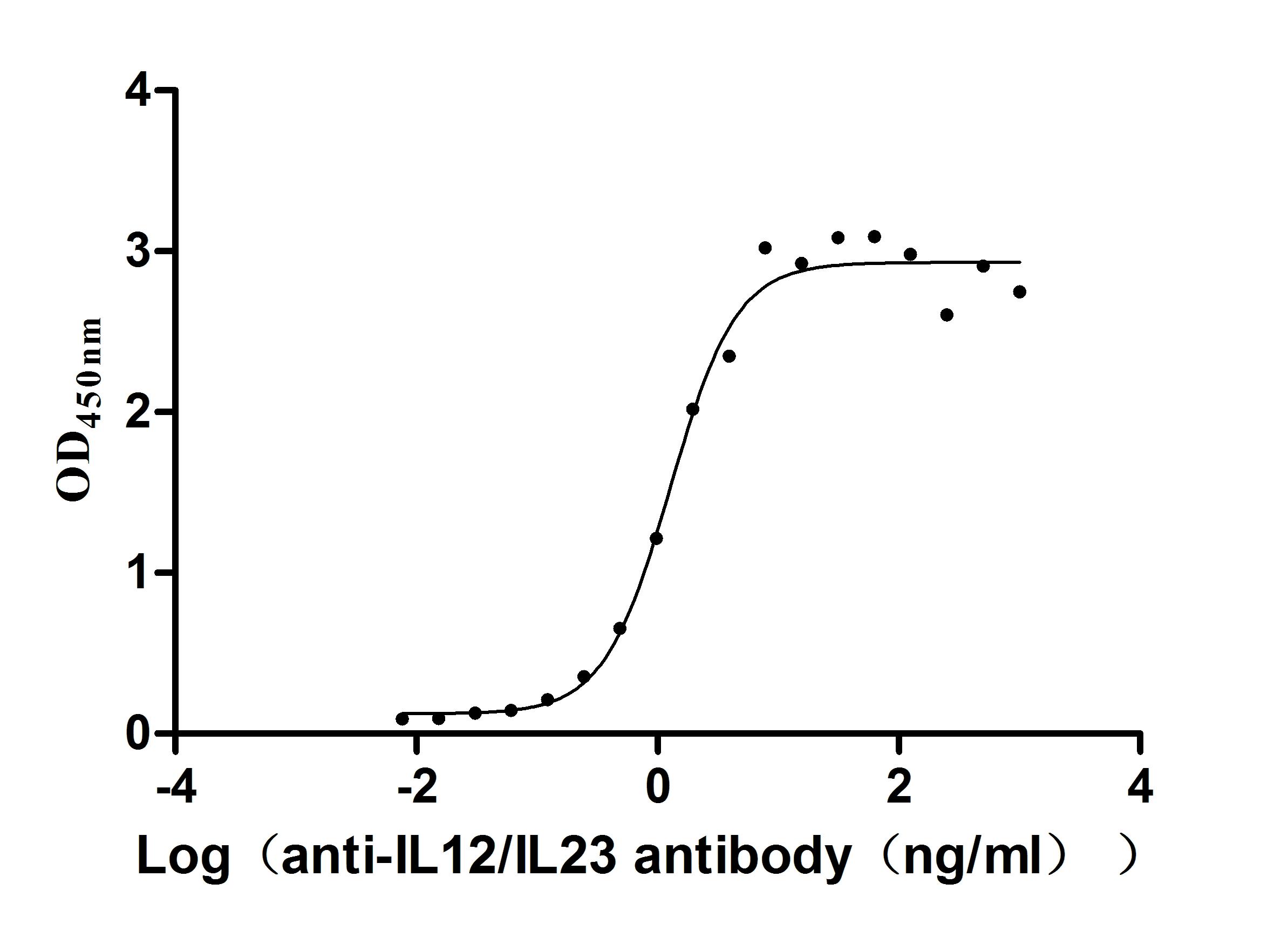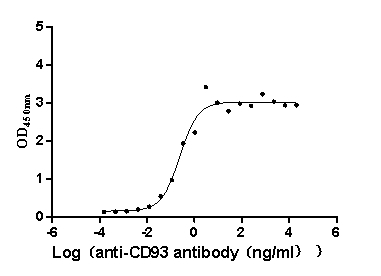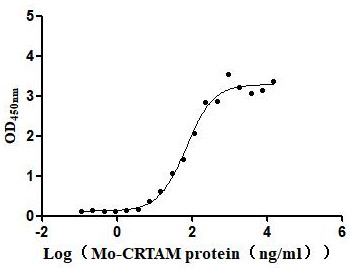Recombinant Mouse Nuclear receptor subfamily 0 group B member 2 (Nr0b2)
-
中文名称:小鼠Nr0b2重组蛋白
-
货号:CSB-YP714014MO
-
规格:
-
来源:Yeast
-
其他:
-
中文名称:小鼠Nr0b2重组蛋白
-
货号:CSB-EP714014MO
-
规格:
-
来源:E.coli
-
其他:
-
中文名称:小鼠Nr0b2重组蛋白
-
货号:CSB-EP714014MO-B
-
规格:
-
来源:E.coli
-
共轭:Avi-tag Biotinylated
E. coli biotin ligase (BirA) is highly specific in covalently attaching biotin to the 15 amino acid AviTag peptide. This recombinant protein was biotinylated in vivo by AviTag-BirA technology, which method is BriA catalyzes amide linkage between the biotin and the specific lysine of the AviTag.
-
其他:
-
中文名称:小鼠Nr0b2重组蛋白
-
货号:CSB-BP714014MO
-
规格:
-
来源:Baculovirus
-
其他:
-
中文名称:小鼠Nr0b2重组蛋白
-
货号:CSB-MP714014MO
-
规格:
-
来源:Mammalian cell
-
其他:
产品详情
-
纯度:>85% (SDS-PAGE)
-
基因名:Nr0b2
-
Uniprot No.:
-
别名:Nr0b2; Shp; Nuclear receptor subfamily 0 group B member 2; Orphan nuclear receptor SHP; Small heterodimer partner
-
种属:Mus musculus (Mouse)
-
蛋白长度:full length protein
-
表达区域:1-260
-
氨基酸序列MSSGQSGVCP CQGSAGRPTI LYALLSPSPR TRPVAPASHS HCLCQQQRPV RLCAPHRTCR EALDVLAKTV AFLRNLPSFC HLPHEDQRRL LECCWGPLFL LGLAQDAVTF EVAEAPVPSI LKKILLEEAS SGTQGAQPSD RPQPSLAAVQ WLQRCLESFW SLELGPKEYA YLKGTILFNP DVPGLRASCH IAHLQQEAHW ALCEVLEPWY PASQGRLARI LLMASTLKNI PGTLLVDLFF RPIMGDVDIT ELLEDMLLLR
-
蛋白标签:Tag type will be determined during the manufacturing process.
The tag type will be determined during production process. If you have specified tag type, please tell us and we will develop the specified tag preferentially. -
产品提供形式:Lyophilized powder
Note: We will preferentially ship the format that we have in stock, however, if you have any special requirement for the format, please remark your requirement when placing the order, we will prepare according to your demand. -
复溶:We recommend that this vial be briefly centrifuged prior to opening to bring the contents to the bottom. Please reconstitute protein in deionized sterile water to a concentration of 0.1-1.0 mg/mL.We recommend to add 5-50% of glycerol (final concentration) and aliquot for long-term storage at -20℃/-80℃. Our default final concentration of glycerol is 50%. Customers could use it as reference.
-
储存条件:Store at -20°C/-80°C upon receipt, aliquoting is necessary for mutiple use. Avoid repeated freeze-thaw cycles.
-
保质期:The shelf life is related to many factors, storage state, buffer ingredients, storage temperature and the stability of the protein itself.
Generally, the shelf life of liquid form is 6 months at -20°C/-80°C. The shelf life of lyophilized form is 12 months at -20°C/-80°C. -
货期:Delivery time may differ from different purchasing way or location, please kindly consult your local distributors for specific delivery time.Note: All of our proteins are default shipped with normal blue ice packs, if you request to ship with dry ice, please communicate with us in advance and extra fees will be charged.
-
注意事项:Repeated freezing and thawing is not recommended. Store working aliquots at 4°C for up to one week.
-
Datasheet :Please contact us to get it.
靶点详情
-
功能:Transcriptional regulator that acts as a negative regulator of receptor-dependent signaling pathways. Specifically inhibits transactivation of the nuclear receptor with which it interacts. Inhibits transcriptional activity of NEUROD1 on E-box-containing promoter by interfering with the coactivation function of the p300/CBP-mediated transcription complex for NEUROD1. Essential component of the liver circadian clock which via its interaction with NR1D1 and RORG regulates NPAS2-mediated hepatic lipid metabolism. Regulates the circadian expression of cytochrome P450 (CYP) enzymes. Represses: NR5A2 and HNF4A to down-regulate CYP2C38, NFLI3 to up-regulate CYP2A5, BHLHE41/HNF1A axis to up-regulate CYP1A2, CYP2E1 and CYP3A11, and NR1D1 to up-regulate CYP2B10, CYP4A10 and CYP4A14.
-
基因功能参考文献:
- ChREBP and SHP control the regulation of hepatic microsomal triglyceride transfer protein expression and VLDL Secretion. Adenoviral Overexpression of ChREBP and SHP Respectively Increased and Decreased Mttp Expression PMID: 29518948
- These results demonstrate a function of RanBP2-mediated SUMOylation of SHP in maintaining bile acids (BA) homoeostasis and protecting from the BA hepatotoxicity. PMID: 27412403
- Data indicate aryl hydrocarbon receptor (AhR) and small heterodimer partner (SHP) as new physiological regulators of phosphatidylcholines (PC) and S-adenosylmethionine (SAM) levels. PMID: 29416063
- Data confirm that hepatic stellate cell activation and alteration in hepatic gene expression observed in offspring of dames on vitamin A-deficient diet from mid-gestation are dependent on retinol and Shp/Nr0b2; these alterations in the offspring are reversed by high-fat diet. PMID: 28570941
- deletion sufficient to protect against fatty liver PMID: 28586124
- SHP deficiency protects myocardia from lipid accumulation in high fat diet-fed mice. PMID: 29016649
- human microbiota was able to reduce the levels of tauro-beta-muricholic acid and induce expression of FXR target genes Fgf15 and Shp in ileum after long-term colonization. We show that a human microbiota can change BA composition and induce FXR signaling in colonized mice, but the levels of secondary BAs produced are lower than in mice colonized with a mouse microbiota PMID: 27956475
- SHP and REV-ERBalpha play a critical role in controlling rhythmic CHOP expression in alcoholic fatty liver PMID: 27664470
- our results suggest that SHP upregulation upon high-fat feeding leads to lipid accumulation, insulin resistance and inflammation in cardiomyocytes. PMID: 28214558
- Mortality of SHP-/- mice after ethanol binge feeding was significantly reduced and Aldh2 mRNA level was higher. After an intoxicating dose of ethanol, SHP-/- mice exhibited faster blood ethanol clearance. PMID: 26968209
- Our results suggest that SHP is required for both antidiabetic and hypolipidemic effects of TZDs in ob/ob mice through regulation of PPARgamma expression. PMID: 25951943
- These data are suggestive of a role for SHP in controlling NLRP3 inflammasome activation through a mechanism involving interaction with NLRP3 and maintenance of mitochondrial homeostasis. PMID: 25655831
- LSD1 is a novel histone-modifying enzyme in the orchestrated regulation mediated by the farnesoid X receptor and small heterodimer partner that reduces hepatic bile acid levels and protects the liver against bile acid toxicity. PMID: 25545350
- SHP ablation creates a proinflammatory phenotype which is exacerbated after sleeve gastrectomy despite weight loss. These inflammatory alterations are possibly related to factors extrinsic to a direct manifestation of Non-alcoholic fatty liver. PMID: 25376397
- Data indicate that EE2-induced cholestasis increases SHP and represses CYP2D6 expression in Tg-CYP2D6 mice in part through ERa transactivation of Shp promoter. PMID: 25943116
- Neonatal exposure to diethylstilbestrol alters adult hepatic physiology in an SHP-dependent manner. PMID: 25263461
- Disruption of Shp in mice alters timing of expression of genes that regulate homocysteine metabolism and the liver responses to ethanol and homocysteine. SHP inhibits the transcriptional activation of Bhmt and cystathionine gamma-lyase by FOXA1. PMID: 25701738
- These results establish SHP as a novel antihypertrophic regulator that acts by interfering with GATA6 signaling. PMID: 25015078
- Shp and Npas2 crosstalk is essential to maintain hepatic lipid homeostasis. PMID: 25212631
- link between hypothalamo-pituitary axis and NR0B2 in testicular androgen metabolism PMID: 25426871
- SHP plays a major role in Retinoic acid-induced potential changes in pathophysiology of metabolic disorders in the liver. PMID: 25014134
- SHP repressed HNF4alpha transactivation of CYP2D6 promoter. PMID: 24318876
- These results indicate that the N-terminal domain of SHP is important for its nuclear translocation via HNF4alpha. PMID: 23874642
- SHP deficiency ameliorates hyperglycemia and preserves islet function by inhibiting apoptosis of pancreatic beta cells and up-regulating of their enriched transcriptional factors. PMID: 23680671
- This study identifies PKCzeta as a novel key upstream regulator of BA-regulated SHP function, revealing the role of Thr-55 phosphorylation in epigenomic regulation of liver metabolism. PMID: 23824184
- HNF4alpha and LRH-1 promote active transcription histone marks on the Cyp7a1 promoter that are reversed by FGF19 in a SHP-dependent manner PMID: 23038264
- Dnmt1 expression is increased in SHP-knockout mice but decreased in SHP-transgenic mice. PMID: 22362755
- the impact of small heterodimer partner (SHP) deletion on diet-induced obesity and insulin resistance PMID: 21949050
- control network for Egr-1 expression through a feedback loop between SHP and HNF4alpha. PMID: 21725089
- small heterodimer partner protein may act as a ligand-regulated receptor in metabolic pathways PMID: 21566081
- SHP is a transcriptional coreprssor in the liver, acting to negatively regulate toll-like receptor signaling at multiple levels. PMID: 21725320
- Study provides evidence for nuclear receptor mediated regulation of Dnmt1 expression through ERRgamma and SHP crosstalk. PMID: 21459093
- The activity of SHP is also increased by posttranslational methylation at Arg-57 by protein arginine methyltransferase 5 (PRMT5). PMID: 21262773
- our results suggest that Sirt1 can both positively and negatively regulate hepatic gluconeogenesis through FoxO1 and Nr0b2 PMID: 21081708
- Fxr-/-Shp-/- mice exhibited cholestasis and liver injury as early as 3 weeks of age with strong induction of cytochrome P450, family 17, subfamily a, polypeptide 1 (Cyp17a1) PMID: 21123943
- These findings provide evidence for a role of Nrf2 in the modulation of hepatic lipid homeostasis through transcriptional activation of SHP and lipogenic gene expression. PMID: 20930048
- SHP acts as a novel positive regulator of bone formation by augmenting osteoblast differentiation through regulation of the transcriptional activity of Runx2 PMID: 19594294
- Results suggest a mechanism by which activation of FXR efficiently induces SHP transcription is through head-to-tail chromatin looping. PMID: 20444884
- The results suggest that SHP inhibits PAI-1 expression in VSMCs through the suppression of TGF-beta/Smad3 and AP-1 activity. PMID: 19887897
- an unexpected role of the FXR/SHP pathway in controlling SIRT1 levels via miR-34a inhibition PMID: 20185821
- SHP activation in adipocytes strongly affects weight gain and diet-induced obesity. PMID: 20124506
- SHP regulates a mechanism by which apoptotic signals can mediate local control of mitochondrial function and apoptosis, which in turn may limit tumorigenesis. PMID: 20065042
- SHP activates miR-206 expression via a cascade dual inhibitory mechanism PMID: 19721712
- During postnatal development, Nr0b2-null mice were resistant to DES-mediated inhibition of germ cell differentiation, which may be the result of interference by Nr0b2 with retinoid signals that control meiosis. PMID: 19884658
- isolation of mouse E1A-like inhibitor of differentiation 1 (EID1) as a candidate coinhibitor for SHP PMID: 11964378
- orphan receptor small heterodimer partner expression is regulated by estrogen receptor alpha PMID: 12842887
- orphan nuclear receptor small heterodimer partner promoter is regulated by sterol regulatory element binding protein-1 PMID: 15123650
- the orphan nuclear receptor SHP (NR0B2) is a negative regulator of PGC-1alpha expression in brown adipocytes; mice lacking SHP show increased basal expression of PGC-1alpha, increased energy expenditure, and resistance to diet-induced obesity PMID: 16213225
- LRH-1 and SHP1 regulate 3-hydroxy-3-methylglutaryl coenzyme A reductase promoter and have a role in regulation of cholesterol synthesis and uptake PMID: 16282330
- SHP and secretin are potentially co-expressed and lead us to propose a novel regulatory pathway PMID: 16888194
显示更多
收起更多
-
亚细胞定位:Cytoplasm. Nucleus.
-
蛋白家族:Nuclear hormone receptor family, NR0 subfamily
-
组织特异性:Expressed in islets of Langerhans (at protein level). Expressed in a circadian manner in the liver.
-
数据库链接:
KEGG: mmu:23957
STRING: 10090.ENSMUSP00000039175
UniGene: Mm.346759
Most popular with customers
-
Recombinant Human Cytotoxic T-lymphocyte protein 4 (CTLA4), partial (Active)
Express system: Mammalian cell
Species: Homo sapiens (Human)
-
Recombinant Human Growth hormone receptor (GHR), partial (Active)
Express system: Mammalian cell
Species: Homo sapiens (Human)
-
Recombinant Human T-cell surface protein tactile (CD96), partial (Active)
Express system: Mammalian cell
Species: Homo sapiens (Human)
-
Recombinant Human Zymogen granule protein 16 homolog B (ZG16B) (Active)
Express system: Mammalian cell
Species: Homo sapiens (Human)
-
Recombinant Human Epithelial discoidin domain-containing receptor 1 (DDR1), partial (Active)
Express system: Mammalian cell
Species: Homo sapiens (Human)
-
Recombinant Human IL12B&IL12A Heterodimer Protein (Active)
Express system: Mammalian cell
Species: Homo sapiens (Human)
-
Recombinant Macaca fascicularis CD93 molecule (CD93), partial (Active)
Express system: Mammalian cell
Species: Macaca fascicularis (Crab-eating macaque) (Cynomolgus monkey)
-
Recombinant Mouse Cell adhesion molecule 1 (Cadm1), partial (Active)
Express system: Mammalian cell
Species: Mus musculus (Mouse)


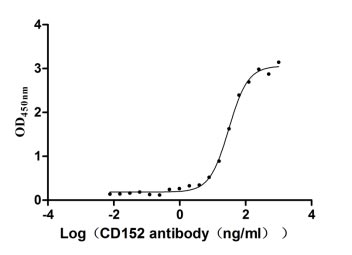
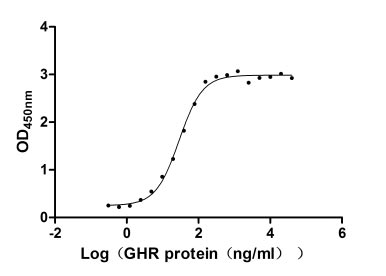
-AC1.jpg)


